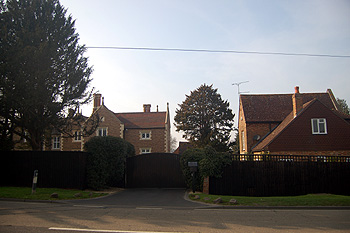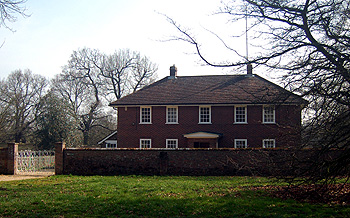Woburn Vicarages

Side and rear view of 46 Bedford Street [May 2012]
Until 1869 Woburn did not have a vicar but a perpetual curate. Nevertheless, the Duke of Bedford, who appointed the curate, allowed him a house, which he did not have to do – the curate of Elstow, for example, was forced to provide his own lodgings, which he usually found in nearby Bedford. It is not known at what date the curate was first provided with a parsonage, the earliest date we know of being 1802 when John Parry was occupying The Old Parsonage at 46 Bedford Street [P118/28/2].
This building was listed by the former Ministry of Works in October 1952 as Grade II*, in the highest class of interesting buildings. The ministry’s architect considered the building to be mid 18th century “possibly encasing an earlier core”. This might suggest that it was a building damaged in the 1724 fire which destroyed thirty nine dwellings. Alternatively the date may be that at which the Duke altered an old building or built a new one specifically for the curate. The house is built of brick, rendered and painted, with steeply pitched clay tiled roofs. It is built in an L-shape and comprises two storeys and attics. In 1817 an estimate was made to build a new room at the parsonage [R4/608/18]. In 1856 the curate acknowledged that he occupied his house solely by permission of the Duke [R4/885].

The Old Vicarage and The Cottage March 2012
At some point during the 19th century a new parsonage was built at the junction of Bedford Street and Crawley Road. This may have happened around the time New Saint Mary’s was being built (1865-1868) because it looks as if in 1869 the curate became a vicar with New Saint Mary’s becoming the official parish church. At any rate, the building is shown as the Vicarage on the first edition 25 inches to the mile Ordnance Survey map of Woburn of 1882. A parish receipt and expenditure book details money spent on the property from 1904 to 1906 [P118/28/6].
The Rating and Valuation Act 1925 specified that every building and piece of land in the country was to be assessed to determine its rateable value. Woburn, like much of the county was valued in 1927 and the valuer visiting The Vicarage [DV1/C137/76] found that it comprised a reception room, a living room, a study, a nursery, a kitchen and scullery and a pantry downstairs. Seven bedrooms and a bathroom lay upstairs. A washhouse, barn and maid’s W. C. lay outside along with a stable for two horses, a trap house with a loft over and an earth closet as well as a poultry house. An outbuilding to the north-east of the house [DV1/C137/77] was “used as gym” it comprised a large house measuring 60 feet 3 inches by 28 feet 6 inches and a small room measuring 25 feet by 16 feet.
At the same time the valuer visiting the The Old Parsonage [DV1/C137/8] found it was still owned by the Vicar of Woburn and was used as Woburn Men’s Club who paid rent of £22 per annum. The building contained a card room measuring 13 feet 6 inches square and a billiard room (“small”) measuring 20 feet by 13 feet 6 inches, another billiards room measuring 18 feet 6 inches by 26 feet 6 inches, a urinal and W. C. on the ground floor. There was also a cellar. The first floor comprised a meeting room measuring 33 feet 6 inches by 13 feet 6 inches and a spare room (“locked”) measuring 11 feet 6 inches by 12 feet 6 inches. There were also two attics. This property later became an antique shop.
Today [2012] Woburn Vicarage is in Park Street, the Old Vicarage being a private dwelling. Parochial Church Council minutes reveal that the vicar moved to the new vicarage in 1960 [P118/32/2].

The Vicarage March 2012